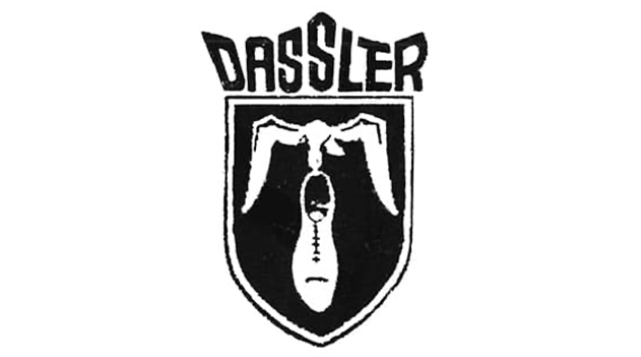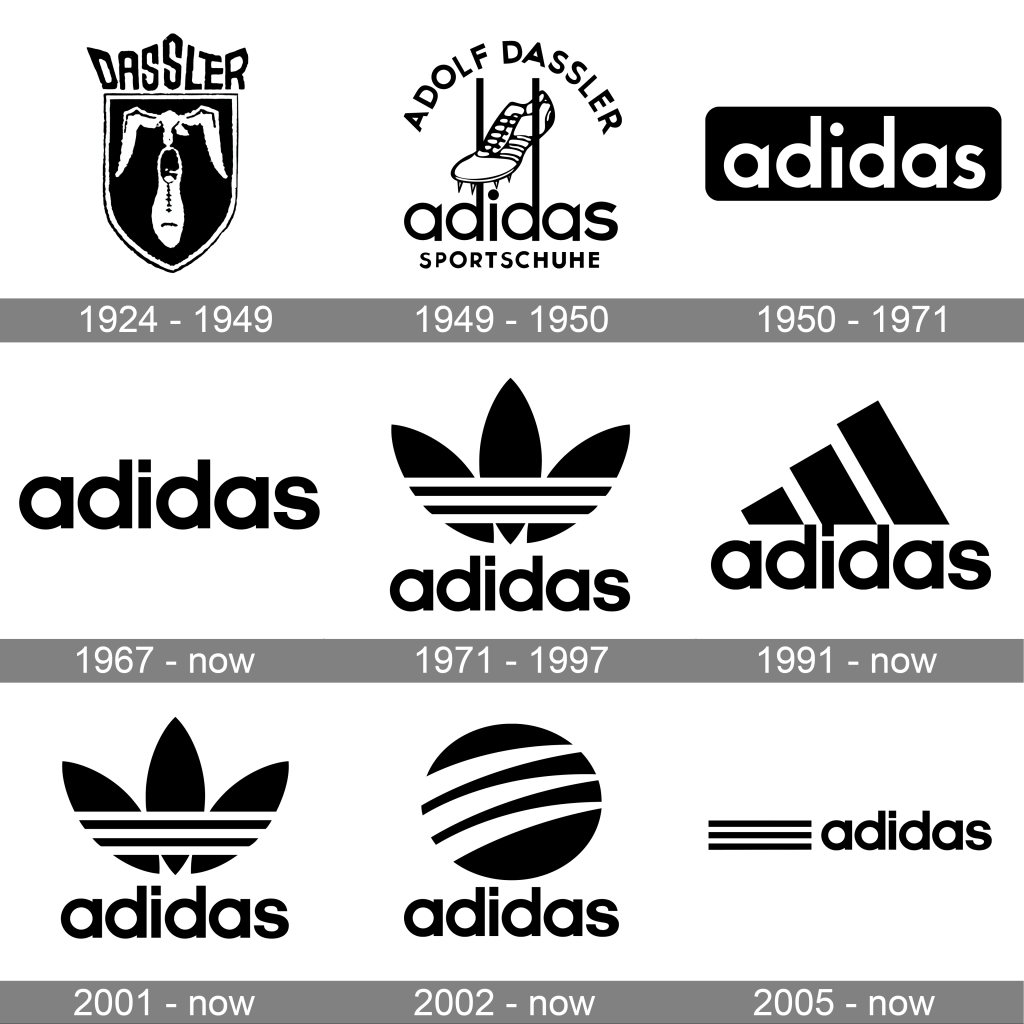Every great brand tells a story, but only a few narratives endure through time, transcending generations and becoming universally recognizable. One such brand is Adidas, whose history is as intricate and fascinating as the woven threads of its iconic shoes. The Adidas story is one that resonates with sneaker enthusiasts, athletes, and even casual consumers. Let’s embark on an exploration of the evolution and significance of the Adidas logo.
1924-1949: The Initial Years of the Adidas Logo

Germany, 1924. Amidst the bustling streets, Adolf “Adi” Dassler was hard at work, meticulously crafting shoes. While his workshop lacked the globally recognized Adidas logo, it brimmed with dedication to innovation and quality. Dassler’s initial focus was purely on functional excellence — producing footwear that met the athlete’s specific needs, from sprinters to footballers. Every shoe was a testament to his commitment, a precursor to the eventual birth of the iconic Adidas logo.
1949-1950: Beginning Anew

Following the parting of ways with his brother, Adi embarked on a quest for a distinctive brand identity, giving birth to Adidas. Meanwhile, Rudolf established Puma, with a primary focus on crafting soccer footwear. The inaugural Adidas logo, bearing Adi’s name and the iconic track spikes that became synonymous with his reputation, adorned the brand during its early foundational phase.
1950-1971 The Simplification of the Logo

The more streamlined logo, retaining the original name, gained widespread acceptance. This revised design omitted the shoe and the phrase “sportschuhe,” and also underwent a subtle font modification.
The logo continued to embrace the monochrome color palette from its predecessors, a tradition that would be upheld in all subsequent logos.
1971-now: The Emergence of the Trefoil

Post World War II, the world saw an evolution in fashion, culture, and branding. Responding to this change, Adidas introduced the world to its legendary three-stripe logo. These three simple lines, though seemingly elementary, encapsulated the essence of the brand, particularly in the sporting world. The trefoil, debuting later, further refined the brand image. Symbolizing unity amidst diversity, this logo was crafted in homage to the Olympics, intertwining the brand’s identity with global sportsmanship.
1991-now: The Mountain Logo Era

The 70s and 80s brought with them an era of exploration and self-discovery. Adidas, aligning itself with the zeitgeist of the times, introduced the ‘Mountain’ logo. More than a mere design shift, this logo symbolized obstacles, goals, and the relentless pursuit of success. Every ridge in the design whispered tales of challenges faced and surmounted, making it more than just an emblem; it became a narrative of ambition and tenacity.
2002-2005: The Recent Innovations in Adidas Logo

The 21st century ushered in an era of digital revolution and unprecedented design innovations. Adidas, always at the forefront of evolution, reimagined its logo for a new generation. By weaving classic elements with modern design principles, the brand maintained a fine balance, ensuring the logo resonated with both long-time fans and newcomers.
2005-now: The Horizontal Adidas Logo

Presenting the latest Adidas logo, introduced in 2005. It’s characterized by horizontal, straight stripes extending from left to right. Its minimalist design ensures swift recognition.
Insights into the Current Adidas Branding Strategy
Adidas’ branding isn’t static; it’s an evolving tapestry of its storied past and visionary future. Drawing richly from its iconic symbols while staying attuned to emerging design trends, Adidas ensures that its logos and branding strategies remain fresh and deeply rooted in its unparalleled history.
Understanding the Adidas Logo Today
While logos often evolve with time, few remain enduring symbols of a brand’s ethos. Today, the Adidas logo stands not just as a mark of quality sportswear but as an emblem of decades of innovation, resilience, and a deep-rooted passion for sports. Whether it’s on a sneaker, a jersey, or a cap, that logo carries with it tales of legends, both from the tracks and the brand’s journey.

5 Interesting Facts About Adidas History
Split Town: The town of Herzogenaurach, where both Adidas and Puma were founded, was famously split due to the rivalry between the two companies. This divide was so deep that there were “Adidas” and “Puma” restaurants, bakeries, and other establishments. Residents were known to be loyal to one brand or the other, often based on their employment.
Run-DMC Connection: In the 1980s, the hip-hop group Run-DMC released “My Adidas”, a song that celebrated the brand and its Superstar shoes. This unintentional promotion led to Adidas forming one of the first ever non-athletic endorsement deals with the group, emphasizing the influence of music culture on fashion.
Space-Faring Sneakers: In partnership with NASA and the International Space Station’s U.S. National Laboratory, Adidas sent its Boost shoe technology to space in 2019. The aim was to study the foam molding process in microgravity, which could lead to further innovations in sneaker design and production.
World Record Shoes: At the 2012 London Olympics, Adidas athletes set 26 new world records. The brand’s Adizero Prime SP, a track spike, was dubbed the “fastest shoe on the planet” and played a role in achieving those records.
Digital Innovation: Beyond physical products, Adidas launched a smartphone app called “Glitch” in 2017. This app was unique as it allowed users to design their own soccer cleats, and it also utilized a referral-only approach for access. This approach highlighted Adidas’ blend of technology and fashion-forward thinking.
Frequently Asked Questions About the Adidas Logo
Why does the Adidas logo have three stripes?
The three stripes were initially added to the company’s footwear to enhance the shoe’s stability. Over time, they became an iconic identifier for the brand.
What is the difference between the trefoil and the performance logo?
The trefoil logo features three leaves and the iconic three stripes, emphasizing heritage and the brand’s history. The performance logo, on the other hand, has three bars at an angle forming a triangle, representing Adidas’s focus on performance and forward momentum.
Who designed the original Adidas logo?
The original Adidas logo with the three stripes was created by the brand’s founder, Adi Dassler.
Why did Adidas choose the color black for many of its logos?
Black is often associated with strength, power, and sophistication. Adidas chose it for many of its logos to convey durability and premium quality. However, over the years, the brand has incorporated various colors based on collections, collaborations, and specific products.
Has the Adidas logo ever been a subject of controversies or legal issues?
Yes, Adidas is protective of its three-stripe mark and has been involved in several legal disputes over the years to prevent other companies from using similar designs. They assert that the three stripes are distinctive and have a strong association with the Adidas brand, and any similar use by competitors could cause confusion in the market.
Create your own logo with Logomak
Impressed by Adidas’s iconic branding journey? Aspiring to craft your brand story? Dive into the realm of logo creation with tools like Logomak. Draw inspiration from giants like Adidas and embark on your branding odyssey.
Final words
Lacing up those three-striped shoes or pulling on that trefoil hoodie is more than a fashion statement; it’s a nod to a legacy. Through decades, highs, and lows, Adidas has emerged not just as a brand but as a movement, and for countless enthusiasts worldwide, a way of life.






In fact, there was one difference in the 1971- logo – from the bottom, the second stripe (black) was not one continuous line, but three short stripes.